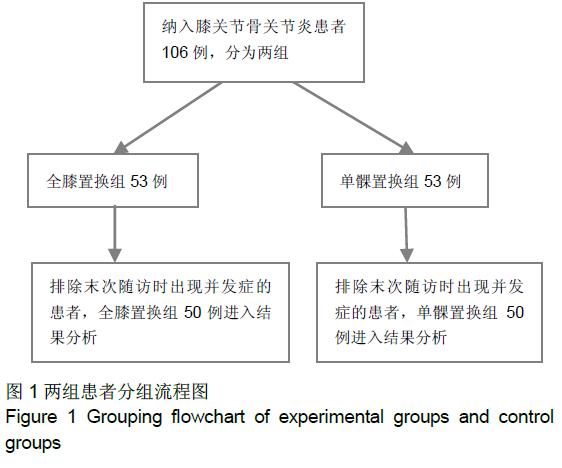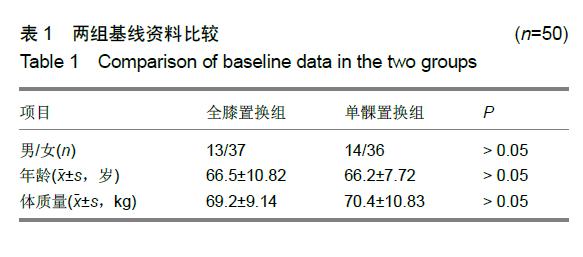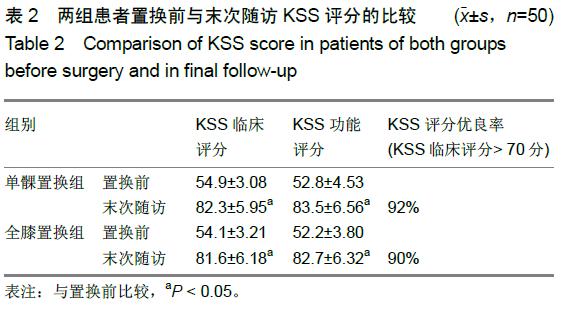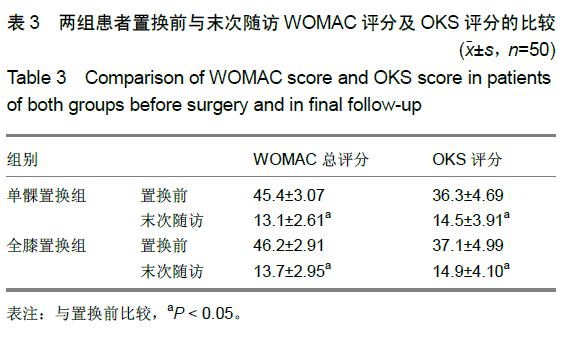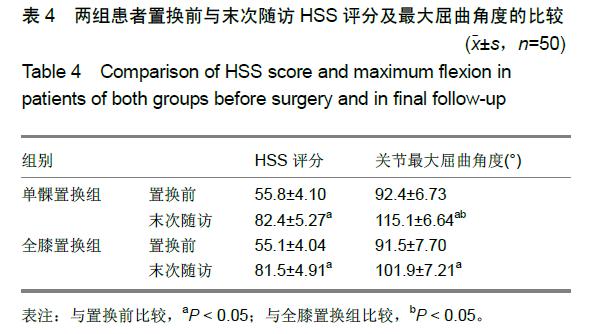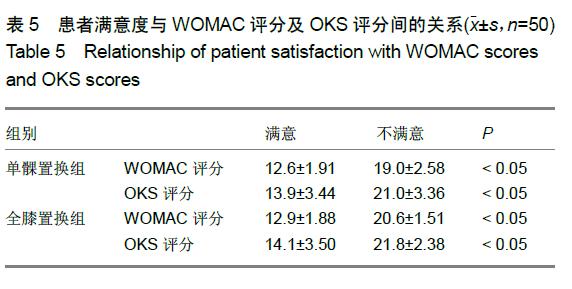Chinese Journal of Tissue Engineering Research ›› 2015, Vol. 19 ›› Issue (48): 7724-7730.doi: 10.3969/j.issn.2095-4344.2015.48.003
Previous Articles Next Articles
Knee scores of patients undergoing unicompartmental knee arthroplasty and total knee arthroplasty: a randomized controlled trial
Peng Song, Xu Bo-yong, Cao Li
- Department of Joint Surgery, the First Affiliated Hospital of Xinjiang Medical University, Urumqi 830000, Xinjiang Uygur Autonomous Region, China
-
Received:2015-09-15Online:2015-11-26Published:2015-11-26 -
About author:Peng Song, Studying for master’s degree, Department of Joint Surgery, the First Affiliated Hospital of Xinjiang Medical University, Urumqi 830000, Xinjiang Uygur Autonomous Region, China -
Supported by:Arthroplasty, Replacement, Knee; Prosthesis Implantation; Osteoarthritis; Tissue EngineeringFunding: the Public Welfare Industry Scientific Research Project of Ministry of health, No. 210302007
CLC Number:
Cite this article
share this article
|
[1] Marmor L.Unicompartmental knee arthroplasty:10 to 13 yearfollowup study.Clin Orthop. 1988;226:14-20.
[2] Jain RK, Neville LT, Kace PA, et al. Two year follow-up of the preservation unicompartmental knee implant. HSSJ. 2011;7: 125-129.
[3] Insall JN, Aglietti P. A five to seven- year follow up of unicondylar arthroplasty. J Bone Joint Surg(Br). 1980;62(11): 1329-1337.
[4] 安雪军,张宇明,魏杰,等.单髁置换术与全膝关节置换术治疗膝关节骨关节炎临床疗效的对比研究[J].中国药物与临床, 2014, 14(8):1109-1110.
[5] 刘晓东,蔡珉巍,涂意辉.微创单髁置换术治疗膝关节内侧间室骨性关节炎的初步临床报告[J].中国矫形外科杂志,2010,18(7): 548-552.
[6] Laskin RS.Unicompartmental tibio femoral resurfacing arthroplasty.J Bone Joint Surg Am. 1978;60(2):182-185.
[7] Christensen NO.Unicompartment alprosthesis forgon arthrosis:an ine year series of 575 knees from a Swedish hospital.Clin Orthop Relat Res. 1991;273:165-169.
[8] 朱超华,陈百成.单髁置换后翻修与初次行全膝关节置换患者远期临床效果对比:49例患者8-17年的随访[J].中国矫形外科杂志, 2011,19(1):86-88.
[9] Newman J,Pydisetty RV,Ackroyd C. Unicompartmental or total knee replacement:the 15 year results of a prospective randomised controlled trail. J Bone Joint Surg(Br). 2009;91(1): 52-57.
[10] Pandit H,Jenkins C,Gill HS,et al.Unnecessary contrainadications for mobile-bearing unicompartmental knee replacement. J Bone Jiont Surg(Br). 2011;93(5):622-628.
[11] 钮铭,薛明新.膝关节骨性关节炎的综合康复治疗进展[J].海南医学,2013, 24(5):742-744.
[12] 唐恒涛,赵亮,燕华,等.OXFORDⅢ单髁系统治疗膝关节内侧间室退变的中期疗效[J].中国修复重建外科杂志,2012,26(1): 17-20.
[13] Riddle DL,Jiranek WA,Mcglynn FJ. Yearly incidence of unicompart-mental knee arthroplasty in the United States. J Arthroplasty. 2008;3:408-412.
[14] 郭万首,张启栋,刘朝晖,等.小切口单髁置换术治疗膝关节内侧间室骨关节炎94 膝的中短期疗效研究[J].中国矫形外科杂志, 2011,19(17):1412-1415.
[15] 梁荣伟.单髁置换在膝关节骨性关节炎中的应用[J].河北医学, 2014,20(1):116-119.
[16] 何少斌,刘平.单髁与全膝关节置换术治疗膝单间室骨性关节炎74例疗效对比[J].陕西医学杂志,2014,43(5):593-595.
[17] Keblish PA,Briard JL.Mobile-bearing unicompartmental knee arthr- oplasty:a 2-center study with an 11-year(mean)follow- up. J Arthroplasty. 2004;19(7Suppl2):87-94.
[18] Kozinn SC,Scott RD.Current concepts review: unicompartmental total arthroplasty. J Bone Joint Surg Am. 2004;71(3):145-146.
[19] Soohoo NF,Sharifi H , Kominski G ,et al .Cost effectiveness analys –is of unicompartmental knee arthroplasty as analternative to total Knee arthroplasty for unicompartmental osteoarthritis.J Bone Joint Surg Am. 2006;88(9):1975-1982.
[20] Patil S,Colwell CW, Ezzet KA,et al .Can normal knee kinematic sberesto -red with unicompartmental knee replacement? J Bone Joint Surg Am. 2005;87(2):332-338.
[21] 徐建平,徐卫东,林国兵,等.双膝骨关节炎患者行小切口单髁置换术与全膝关节置换术临床疗效对比分析[J].中华外科杂志,2013, 51(2):157-160.
[22] 张催,陈游,张春雷,等.单髁置换术与全膝关节置换术治疗膝单间室骨性关节炎近中期疗效的对比研究[J].中华关节外科杂志, 2010,4(2):192-197.
[23] 黄淑梅,王卉,田京.Oxford Ⅲ单髁置换治疗膝骨关节炎的近中期疗效分析[J].实用骨科杂志,2013,19(6):503-506.
[24] Stukenborg Colsman C,Wirth CJ,Lazovic D,et al.High tibial osteotomy versus unicompartmental joint replacement in unicompartmental knee joint osteoarthritis:7-10 year follow-up prospective randomised study. J Knee. ,2001;3:187-194.
[25] Scott RD,Cobb AG. Unicompartmental knee arthroplasty:8-12 year follow-up evaluation with survivorship analysis. Clin Orthop Relat Res. 1991;271:96-100.
[26] Amin AK,Patton JT,Cook RE,et al. Unicompartmental or total knee arthroplasty?Results from a matched study. Clin Orthop Relat Res. 2006;451:101.
[27] Sweeney K, Grubisic M, Marra CA, et al.Comparison of HRQL Between Unicompartmental Knee Arthroplasty and Total Knee Arthroplasty for the Treatment of Osteoarthritis.J Arthroplasty. 2013; 28(2):187-190.
[28] Isaac SM,Barker KL,Danial IN,et al. Does arthroplasty typeinfluence knee joint proprioception: a longitudinal prospective study comparing total and unienmpartmental arthroplasty. Knee. 2007;1493:212-217.
[29] Faour-Mertin O,Valverde-Garcia JA,Martin-Ferrero MA,et al.Ox-ford phase 3 unicondylar knee arthroplasty through a minimally invasiveapproach:long term results. Int Orthop. 2013;37(5):833-838.
[30] Laurencin CT,Zeiicof SB,Scott RD,et al.Unicompartmental versus total knee arthroplasty in the same patient: A comparative study. Clin Orthop. 1991;273:151-156.
[31] 李众利,刘玉杰,王岩,等.人工单髁置换治疗膝单间室严重骨关节炎[J].临床骨科杂志,2008,11(2):107-109.
[32] Kozinn SC,Scott R.Unicondylar knee arthroplasty. J Bone Joint Surg(Am). 1989;1:145-150.
[33] 张卫国,夏仁云.人工内侧单髁置换对膝关节伸屈过程中胫骨轴向旋转的影响[J].中国骨与关节损伤杂志,2007,23(3):122-124. |
| [1] | Chen Ziyang, Pu Rui, Deng Shuang, Yuan Lingyan. Regulatory effect of exosomes on exercise-mediated insulin resistance diseases [J]. Chinese Journal of Tissue Engineering Research, 2021, 25(25): 4089-4094. |
| [2] | Chen Yang, Huang Denggao, Gao Yuanhui, Wang Shunlan, Cao Hui, Zheng Linlin, He Haowei, Luo Siqin, Xiao Jingchuan, Zhang Yingai, Zhang Shufang. Low-intensity pulsed ultrasound promotes the proliferation and adhesion of human adipose-derived mesenchymal stem cells [J]. Chinese Journal of Tissue Engineering Research, 2021, 25(25): 3949-3955. |
| [3] | Yang Junhui, Luo Jinli, Yuan Xiaoping. Effects of human growth hormone on proliferation and osteogenic differentiation of human periodontal ligament stem cells [J]. Chinese Journal of Tissue Engineering Research, 2021, 25(25): 3956-3961. |
| [4] | Sun Jianwei, Yang Xinming, Zhang Ying. Effect of montelukast combined with bone marrow mesenchymal stem cell transplantation on spinal cord injury in rat models [J]. Chinese Journal of Tissue Engineering Research, 2021, 25(25): 3962-3969. |
| [5] | Gao Shan, Huang Dongjing, Hong Haiman, Jia Jingqiao, Meng Fei. Comparison on the curative effect of human placenta-derived mesenchymal stem cells and induced islet-like cells in gestational diabetes mellitus rats [J]. Chinese Journal of Tissue Engineering Research, 2021, 25(25): 3981-3987. |
| [6] | Hao Xiaona, Zhang Yingjie, Li Yuyun, Xu Tao. Bone marrow mesenchymal stem cells overexpressing prolyl oligopeptidase on the repair of liver fibrosis in rat models [J]. Chinese Journal of Tissue Engineering Research, 2021, 25(25): 3988-3993. |
| [7] | Liu Jianyou, Jia Zhongwei, Niu Jiawei, Cao Xinjie, Zhang Dong, Wei Jie. A new method for measuring the anteversion angle of the femoral neck by constructing the three-dimensional digital model of the femur [J]. Chinese Journal of Tissue Engineering Research, 2021, 25(24): 3779-3783. |
| [8] | Meng Lingjie, Qian Hui, Sheng Xiaolei, Lu Jianfeng, Huang Jianping, Qi Liangang, Liu Zongbao. Application of three-dimensional printing technology combined with bone cement in minimally invasive treatment of the collapsed Sanders III type of calcaneal fractures [J]. Chinese Journal of Tissue Engineering Research, 2021, 25(24): 3784-3789. |
| [9] | Qian Xuankun, Huang Hefei, Wu Chengcong, Liu Keting, Ou Hua, Zhang Jinpeng, Ren Jing, Wan Jianshan. Computer-assisted navigation combined with minimally invasive transforaminal lumbar interbody fusion for lumbar spondylolisthesis [J]. Chinese Journal of Tissue Engineering Research, 2021, 25(24): 3790-3795. |
| [10] | Hu Jing, Xiang Yang, Ye Chuan, Han Ziji. Three-dimensional printing assisted screw placement and freehand pedicle screw fixation in the treatment of thoracolumbar fractures: 1-year follow-up [J]. Chinese Journal of Tissue Engineering Research, 2021, 25(24): 3804-3809. |
| [11] | Shu Qihang, Liao Yijia, Xue Jingbo, Yan Yiguo, Wang Cheng. Three-dimensional finite element analysis of a new three-dimensional printed porous fusion cage for cervical vertebra [J]. Chinese Journal of Tissue Engineering Research, 2021, 25(24): 3810-3815. |
| [12] | Wang Yihan, Li Yang, Zhang Ling, Zhang Rui, Xu Ruida, Han Xiaofeng, Cheng Guangqi, Wang Weil. Application of three-dimensional visualization technology for digital orthopedics in the reduction and fixation of intertrochanteric fracture [J]. Chinese Journal of Tissue Engineering Research, 2021, 25(24): 3816-3820. |
| [13] | Sun Maji, Wang Qiuan, Zhang Xingchen, Guo Chong, Yuan Feng, Guo Kaijin. Development and biomechanical analysis of a new anterior cervical pedicle screw fixation system [J]. Chinese Journal of Tissue Engineering Research, 2021, 25(24): 3821-3825. |
| [14] | Lin Wang, Wang Yingying, Guo Weizhong, Yuan Cuihua, Xu Shenggui, Zhang Shenshen, Lin Chengshou. Adopting expanded lateral approach to enhance the mechanical stability and knee function for treating posterolateral column fracture of tibial plateau [J]. Chinese Journal of Tissue Engineering Research, 2021, 25(24): 3826-3827. |
| [15] | Zhu Yun, Chen Yu, Qiu Hao, Liu Dun, Jin Guorong, Chen Shimou, Weng Zheng. Finite element analysis for treatment of osteoporotic femoral fracture with far cortical locking screw [J]. Chinese Journal of Tissue Engineering Research, 2021, 25(24): 3832-3837. |
| Viewed | ||||||
|
Full text |
|
|||||
|
Abstract |
|
|||||

